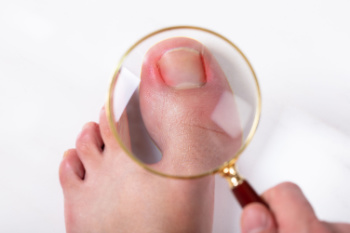
An ingrown toenail occurs when the edge of a toenail grows into the surrounding skin, leading to pain, redness, and sometimes infection. This common problem can make even the simplest tasks uncomfortable, especially when wearing shoes. A podiatrist can relieve the pressure by gently lifting or trimming the affected nail, and treating any infection that may be present. For more advanced cases, a minor in-office procedure can prevent the nail from growing inward again. Wearing shoes with adequate toe room and trimming nails straight across can help reduce future problems. Proper care not only eases discomfort, but also restores confidence in walking and daily movement. If you notice swelling, pain, or drainage around your toenail, it is suggested you promptly schedule an appointment with a podiatrist for a proper diagnosis and appropriate treatment.
Ingrown toenails may initially present themselves as a minor discomfort, but they may progress into an infection in the skin without proper treatment. For more information about ingrown toenails, contact Joseph M. LaCava, DPM of Arkansas. Our doctor can provide the care you need to keep you pain-free and on your feet.
Ingrown Toenails
Ingrown toenails are caused when the corner or side of a toenail grows into the soft flesh surrounding it. They often result in redness, swelling, pain, and in some cases, infection. This condition typically affects the big toe and may recur if it is not treated properly.
Causes
- Improper toenail trimming
- Genetics
- Improper shoe fitting
- Injury from pedicures or nail picking
- Abnormal gait
- Poor hygiene
You are more likely to develop an ingrown toenail if you are obese, have diabetes, arthritis, or have any fungal infection in your nails. Additionally, people who have foot or toe deformities are at a higher risk of developing an ingrown toenail.
Symptoms
Some symptoms of ingrown toenails are redness, swelling, and pain. In rare cases, there may be a yellowish drainage coming from the nail.
Treatment
Ignoring an ingrown toenail can have serious complications. Infections of the nail border can progress to a deeper soft-tissue infection, which can then turn into a bone infection. You should always speak with your podiatrist if you suspect you have an ingrown toenail, especially if you have diabetes or poor circulation.
If you have any questions, please feel free to contact our office located in Hot Springs, AR . We offer the newest diagnostic and treatment technologies for all your foot care needs.
